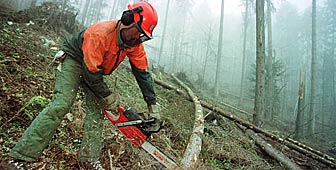Swiss forests recover a year after hurricane

Exactly one year ago, hurricane Lothar swept across Switzerland, killing 14 people and causing widespread damage. Today, the forests are showing signs of recovery, despite the terrible damage inflicted on them.
Lothar, carrying winds of up to 160 kilometres an hour, left a trail of destruction mainly in central Switzerland, snapping trees like matchsticks, cutting swathes through forests and disrupting communications.
More than 10 million trees succumbed to the terrifying winds.
The forest above the central town of Stans was one of the worst-hit in the devastating storms. One year on, efforts to clear away the debris have made substantial progress, and the authorities say there is no danger of major avalanches.
Three-quarters of the forest on the Stanserhorn mountain, near Lake Lucerne, were destroyed by hurricane Lothar on Boxing Day 1999. It prompted fears that the region of Stans, with more than 6,000 inhabitants, could be in danger of avalanches and mudslides from the nearby mountain.
A year later, Urs Braschler, head of the Nidwalden forestry department, has given the all clear: “We can say that the avalanche barriers are intact. The wood that is still lying on the ground will also strengthen protection.”
Braschler warned of an increased risk of rockfalls and landslides in the forests but said they do not pose a direct threat to the town. However, he told swissinfo that the local river could cause flooding as a result of erosion.
The foresters were faced with a number of difficulties in the clear-up operation. Because the slope is so steep, much of the dangerous work had to be done manually. This slowed down progress considerably.
But Braschler says his team had the support of professionals and volunteers and received extra funding from the authorities.
The number of trees blown down by hurricane Lothar in the region of Stans represents the average wood harvest of 10 years.
Despite the destruction of more than 10 million trees in lower-lying areas across Switzerland, the wood industry did not suffer a slump in timber prices. This was mainly due to the flourishing construction industry and an increase in exports to Austria and Italy.
However, Hansruedi Streiff from the Timber Industry Association has criticised the federal authorities for dragging their feet: “It took them too long to ease strict transport regulations for trucks. Other countries were way ahead of Switzerland.”
The Federal Environment Agency says it is reconsidering forestry policy as a result of the hurricane. Mario Broggi told swissinfo that more needs to be done to manage forests with environmentally-friendly methods.
by Urs Geiser

In compliance with the JTI standards
More: SWI swissinfo.ch certified by the Journalism Trust Initiative

You can find an overview of ongoing debates with our journalists here . Please join us!
If you want to start a conversation about a topic raised in this article or want to report factual errors, email us at english@swissinfo.ch.